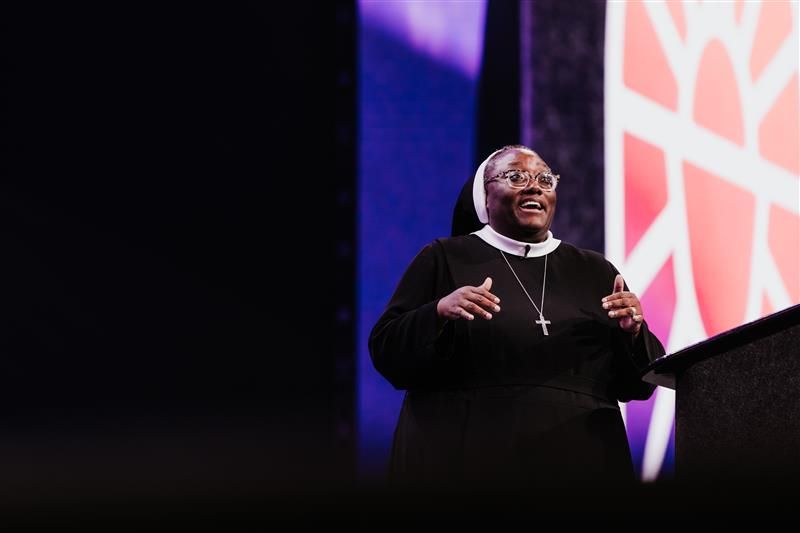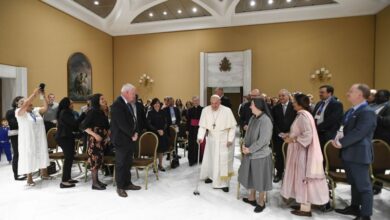Religious sister speaks to 6,000 at National Eucharistic Congress about mental health

 Sister Josephine Garrett gives a keynote talk at the 2024 National Eucharistic Congress in Indianapolis, which took place July 17–21, 2024. / Credit: Casey Johnson in partnership with the National Eucharistic Congress
Sister Josephine Garrett gives a keynote talk at the 2024 National Eucharistic Congress in Indianapolis, which took place July 17–21, 2024. / Credit: Casey Johnson in partnership with the National Eucharistic Congress CNA Staff, Aug 3, 2024 / 07:00 am (CNA).
At last month’s National Eucharistic Congress in Indianapolis, an estimated 6,000 participants attended Sister Josephine Garrett’s breakout session on mental health.
“[The session was] one of the largest ones — which shows you that that issue of mental health is so prevalent in our society today,” Bishop James Conley, who introduced Garrett before her talk, told CNA.
Garrett is a licensed counselor who specializes in treating children and adolescents affected by trauma. She serves as a Catholic school counselor in Tyler, Texas, and is a Sister of the Holy Family of Nazareth. She also hosts a mental-health-oriented podcast called “Hope Stories.”
Garrett’s talk at the congress, called “Healing Community: Encountering Brokenness in the Body of Christ,” incorporated information about current mental health practices such as attachment styles, therapy, boundary setting, and healthy conflict while tying in Catholic spiritual practices like confession, praying with Scripture, and striving for virtue.
Made for relationship: attachment styles
Garrett encouraged attendees to delve into attachment theory, a long-studied concept that’s becoming better known as American culture grows more mental-health aware.
She said she wants to see attachment styles be more incorporated into Catholic mental health “because attachment styles consider how we seek to love and how we seek to connect.”
“If saints are made in relationships, then we need to refine our skills and we need to refine our tools and sharpen our tools to live in virtuous relationships,” she explained.
Attachment theory proposes four attachment styles: secure, anxious, avoidant, and disorganized. Each of us tends toward one of these when forming relationships based on how we formed attachments with our parents and caregivers as young children.
It’s important to understand “how we seek to connect, how we seek to love,” Garrett said. “And our attachment style can help give us information on where we do that, how we do that well, and how we struggle.”
“Because what’s happening when we’re connecting from brokenness is there’s a glaze over us, and so we can’t see things in truth,” she said. “It becomes hard to see things in truth.”
Human beings are biologically wired for connection, she explained, noting that “we bring all of this into our efforts to build a community.”
“We bring our broken attachment style into our efforts to build community. We bring our desire for connection, but that’s coupled with our sinfulness, into our desire for community,” she said in between stories about squabbling nuns that had the audience roaring with laughter.
Garrett highlighted eye movement desensitization and reprocessing (EMDR), a form of therapy that can help clients process trauma. She noted that relational EMDR can help the client reprocess past relationships “so what was broken in the past doesn’t govern the present moment.”
Do not be ashamed
In recent years, mental health issues are being more openly addressed in the Catholic Church, with resources and ministries dedicated to mental health popping up in recent years.
“Thanks be to God that we’re talking about it and that we’re trying to remove the stigma,” Conley told CNA. “Because the worst thing [for] people who are struggling with mental health is to keep it to themselves and to be shamed into not talking about it.”
Conley has had personal experience with anxiety, depression, and insomnia. He became the first bishop to request leave from the pope for mental illness and has shared his story with his flock and beyond.
“It’s a healthy thing to be able to talk about it and share your story, and to know that you’re not alone and there’s nothing to be ashamed of,” he said. “It’d be like, why would you be ashamed? Let’s say if you’re diagnosed with diabetes, would you be ashamed of that? And not tell anybody? It’s the same with mental health.”
“Depression is a heavy burden,” and adding other burdens of shame or dismay onto it only makes it heavier, Garrett noted during her talk.
“Sometimes we’re going into our relationships and we’re struggling and we’re dismayed and [we think] why should I struggle?” she said. “You’re supposed to struggle. You’re a sinner, right? And so we overcomplicate what’s already complicated with this dismay.”
Catholic wisdom for healing in relationships
While reflecting on attachment styles can help “clean your relational lenses,” Garrett also emphasized spiritual practices such as confession, praying with Scripture, and studying virtues as ways to find healing in relationships.
“We have to pray with Scripture — and it’s not hard,” she said. “You open it up, you pick a passage, you read through it, you see what in the passage stood out to you or struck you. Maybe it’s a word or a line. Then you sit with that word or line, and it could be five minutes, 10 minutes, whatever matches where you are now.”
“So if you do not have the prayer of a monk, don’t pretend like you have the prayer of a monk,” she continued. “Because God is satisfied with your sincere offering, not your fake offering.”
“So be sincere with the Lord. If it’s five minutes right now, that’s your offering, and God is pleased with it,” she said.
Garrett also suggested looking at the vices governing one’s sins, to pray for the virtues that are contrary to them, and to take that to confession.
“It informed my prayer to really fill my conscience throughout the day with an awareness of a need to grow in virtue and to ask God to give me the graces and strengths to practice those virtues so I could grow in strength,” she said.
“The vices you struggle with will give you information regarding those virtues,” she added.
“Conflict can be a source of deep growth and connection relationships, provided we approach it seeking connection and not control,” Garrett continued.
Boundaries are “pastoral,” she explained.
“They communicate the dignity of the human person and they establish trust and safety,” she said. “Sometimes we get the idea as Christians that boundaries are not pastoral — but they’re deeply pastoral because they communicate to the other person their dignity and their uniqueness.”
“Jesus had boundaries,” she added. “Look at Luke 8:38. That man wanted to come with him, the demoniac that he healed. And Jesus said, no, you don’t belong with me. Go back to your family. And that was a boundary, and he was no less Lord.”
How healing brings Christ into the world
“We have these lofty ideals but then we come and we bring our brokenness, how then does the pilgrim Church, the body of Christ, move forward?” Garrett reflected.
Garrett encouraged the crowd to “lean in” to these challenging relationships.
“Relationships are a crucible; crucibles place things under pressure so that something beautiful can come out of it,” she said. “Relationships are a crucible, and when we lean into them, it is Christ that is born in the world. It’s the new heaven and the new earth, degree by degree.”
She highlighted writings by St. John Paul II where he explained that Christ entered the world through the door of the family and continues to today.
“When there’s that sacrificial love, God’s love reigns, because, remember, we are a perpetuation of the image [of God],” she said. “When we can have that love between us, his love reigns in the world and is present.”
“We’re called to foster this family spirit as pilgrims moving towards God’s hope, which is a family,” Garrett said.
“What does it do for the body of Christ when we lean in and dig deep and stop being dismayed by our brokenness and run towards it head-on and get in the fight and do the work?” she asked.
“When we lean in, when we don’t move back, when we dig in, in the hardness of these relationships, in the midst of our brokenness, Christ is literally born in the world,” she concluded.






